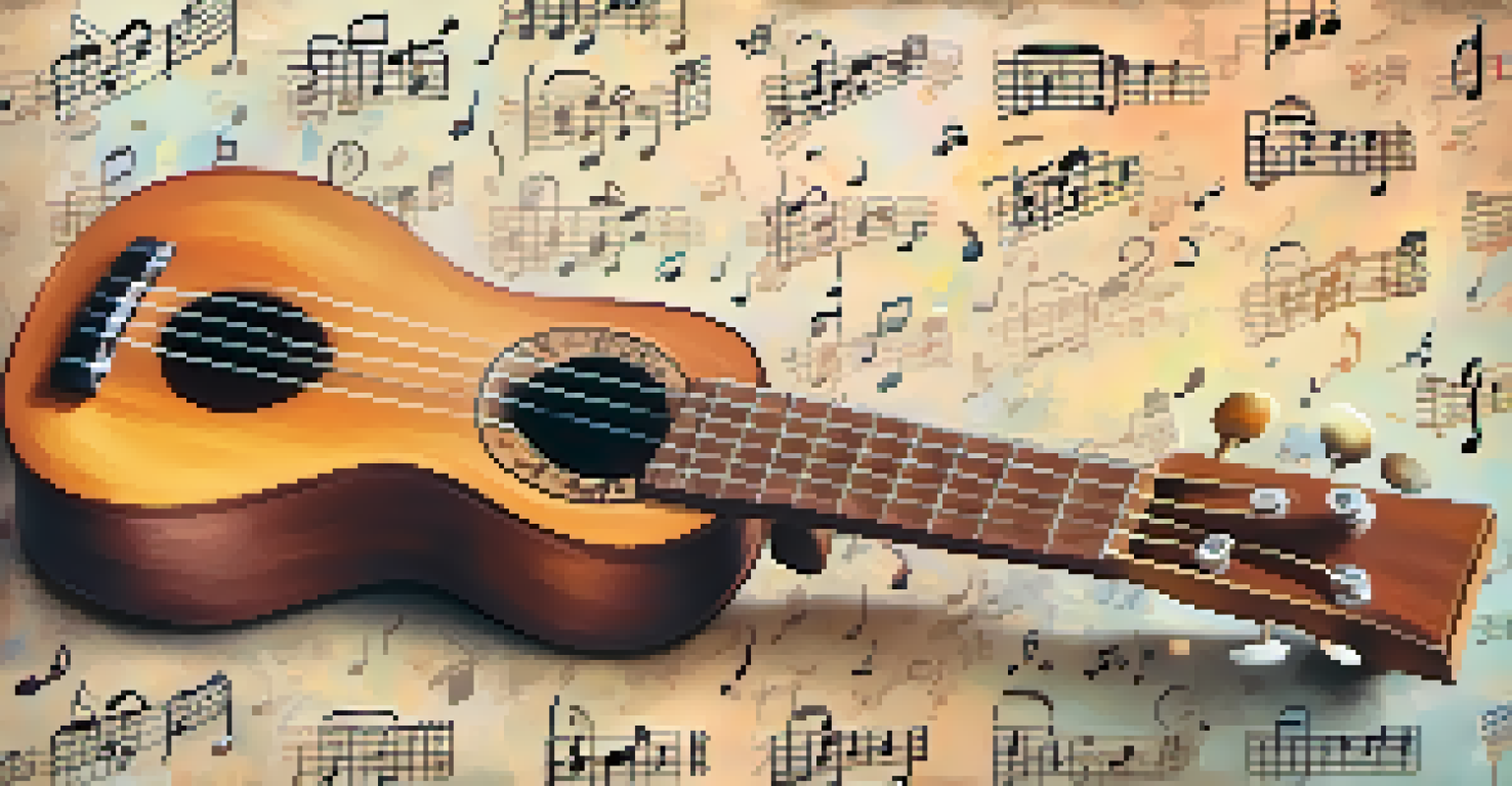The Birth of the Ukulele: Origins and Early Instruments

The Roots of the Ukulele: A Hawaiian Treasure
The ukulele, often associated with the sunny beaches of Hawaii, actually has roots that trace back to Portugal. In the late 19th century, Portuguese immigrants brought a small, guitar-like instrument called the braguinha to the islands. This instrument laid the groundwork for what would eventually evolve into the ukulele.
The ukulele is the ultimate instrument for a beginner; it’s portable, affordable, and fun to play.
As the braguinha made its way into Hawaiian culture, it underwent various modifications. Local craftsmen began altering its size, shape, and tuning to suit the unique musical landscape of Hawaii. This blend of influences resulted in an instrument that was not only easy to play but also captured the island's spirit.
By the early 20th century, the ukulele had firmly established itself as a symbol of Hawaiian music. Its cheerful sound and portability made it popular among both locals and tourists, setting the stage for its rise in popularity beyond the islands.
The Evolution of Early Ukulele Designs
As the ukulele gained traction, various designs began to emerge that catered to different musical styles. Initially, the instrument was crafted in three main sizes: soprano, concert, and tenor. Each size produced a distinct sound, allowing musicians to choose one that best suited their playing style.

The materials used in making ukuleles also varied widely. Early instruments were typically crafted from native woods like koa, which not only provided durability but also contributed to the instrument's warm tone. Over time, manufacturers began experimenting with other materials, such as mahogany and even plastic, to create different sound characteristics.
Ukulele's Hawaiian Roots Explained
The ukulele originated from the Portuguese braguinha, which was adapted by Hawaiian craftsmen to create an instrument that embodies the spirit of the islands.
This period marked a significant transition as the ukulele began to be recognized not just as a folk instrument but as a versatile tool for various music genres. Musicians started pushing the boundaries of its sound, paving the way for innovative playing techniques that would further enhance its appeal.
The Role of Music and Culture in the Ukulele's Popularity
The ukulele's rise in popularity can be closely tied to the cultural movements of the early 20th century. With the advent of jazz and swing music, the instrument found its place in the limelight, often performing alongside larger ensembles. This integration into popular music helped solidify its status as a beloved instrument.
Music is the universal language of mankind.
Events such as the Hawaiian Pavilion at the 1915 Panama-Pacific International Exposition introduced the ukulele to a wider audience. This exposure led to an explosion of interest, inspiring many to pick up the instrument for themselves. The cheerful sounds of the ukulele resonated with people from all walks of life.
As the ukulele continued to evolve, so did the music associated with it. From traditional Hawaiian tunes to contemporary pop songs, the instrument adapted seamlessly, demonstrating its versatility and broad appeal. This cultural significance has kept the ukulele relevant even in today’s diverse music scene.
The Influence of Key Figures in Ukulele History
Throughout its history, several key figures have played pivotal roles in popularizing the ukulele. One notable individual was the celebrated Hawaiian musician, Roy Smeck, who showcased the instrument's potential on stage and in recordings during the 1920s. His virtuosic playing and entertaining performances captivated audiences and inspired many to learn the ukulele.
Another influential figure was the renowned Hawaiian singer and songwriter, Israel Kamakawiwo'ole. His heartfelt renditions of traditional Hawaiian songs, combined with his signature ukulele playing, introduced the instrument to a global audience in the 1990s. His rendition of 'Somewhere Over the Rainbow' remains iconic, demonstrating the emotional depth that the ukulele can convey.
Cultural Impact on Ukulele Popularity
The ukulele's rise in popularity during the early 20th century was fueled by cultural movements and events that introduced it to wider audiences.
These musicians not only showcased the ukulele's charm but also contributed to its ongoing evolution. By blending different musical styles and techniques, they helped shape the instrument into what we know and love today.
The Birth of Ukulele Variations and Models
As the ukulele gained popularity, manufacturers began to create variations and models that appealed to different players. This led to the development of unique styles, including the baritone ukulele, which offers a deeper sound and is often tuned like the top four strings of a guitar. These variations allowed musicians to explore new genres and techniques.
Additionally, the introduction of electric ukuleles in the mid-20th century expanded the instrument's capabilities further. With built-in pickups, players could amplify their sound, making it suitable for larger venues and different music styles. This innovation opened the door for a fusion of traditional ukulele playing with modern rock and pop music.
The growing variety of ukuleles ensured that there was something for everyone, from beginners to experienced musicians. As the instrument evolved, it continued to attract a diverse range of players, each bringing their unique flair to the art of ukulele playing.
The Ukulele's Resurgence in Modern Music
In recent years, the ukulele has experienced a remarkable resurgence in popularity, particularly among younger generations. This renewed interest can be attributed to its accessibility; the instrument is relatively affordable and easy to learn, making it a favorite choice for beginners. Many online tutorials and social media platforms have further fueled this trend.
Musicians like Eddie Vedder of Pearl Jam and Jason Mraz have incorporated the ukulele into their music, introducing it to a broader audience. Their catchy songs and engaging performances have played a significant role in popularizing the instrument in contemporary music. This has inspired countless aspiring musicians to pick up the ukulele and explore its possibilities.
Modern Ukulele's Global Appeal
Today, the ukulele is cherished worldwide, blending seamlessly into various musical traditions and fostering a vibrant community of players.
The ukulele's cheerful sound and portability have also made it a popular choice for casual jam sessions and gatherings. Whether it's a beach bonfire or a backyard barbecue, the ukulele adds a fun and inviting atmosphere, making it a staple in both music and social settings.
The Global Reach of the Ukulele Today
Today, the ukulele is a beloved instrument not just in Hawaii but around the world. From Japan to Europe, the ukulele has found its place in various musical traditions, often blending with local styles. This global reach reflects the instrument's adaptability and universal appeal.
Festivals dedicated to the ukulele are now held worldwide, celebrating its rich history and diverse playing styles. These events bring together enthusiasts of all ages, creating a vibrant community that shares a love for the instrument. It’s not just about playing music; it's about building connections and celebrating creativity.

As the ukulele continues to evolve, it remains a symbol of joy and inclusivity. Its ability to transcend cultural boundaries speaks to the power of music in bringing people together, making the ukulele a timeless instrument that will likely endure for generations to come.